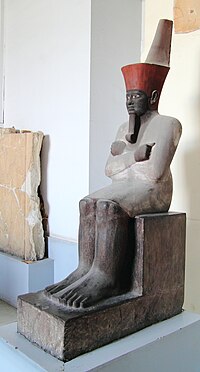Black seated statue of Mentuhotep II.
| Black seated statue of Mentuhotep II. | |
|---|---|

|
|
| material | Sandstone |
| Dimensions | H. 138 cm; |
| origin | Deir el-Bahari , mortuary temple of Mentuhotep II. |
| time | Middle Kingdom , 11th Dynasty (c. 2000 BC) |
| place | Cairo , Cairo Egyptian Museum , JE 36195 |
The black seated statue of Mentuhotep II in the Egyptian Museum in Cairo with the inventory number JE 36195 represents the ancient Egyptian king ( pharaoh ) Mentuhotep II of the 11th dynasty ( Middle Kingdom ), who lived around 2061 to 2010 BC. BC first ruled in Upper Egypt and later established the unification of the empire with Lower Egypt .
Mentuhotep II had a mortuary temple ( mortuary temple of Mentuhotep II ) built on the west bank of Theban in the valley of Deir el-Bahari, which was unique for this time . Historically and structurally, it is an important monument and testament to the transition from the pyramid temples of the Old Kingdom to the millions of years old in the New Kingdom . However, it not only served as a mortuary temple, but also as the actual grave complex. An approximately 150-meter-long shaft led from the rear columned hall to the actual burial chamber in the rock massif.
In 1898, Howard Carter accidentally discovered another complex that can be regarded as the king's second tomb when he collapsed with his horse at this point. This facility is named after Carter's riding horse Bab el-Hosan (“Gate of the Horse”). A dromos, about 40 meters long and sloping down from east to west, leads into the ground. At a depth of 17 m behind a gate, a corridor runs 150 m down into the mountain. In the burial chamber, Carter discovered this black seat of the king next to an empty coffin. Dieter Arnold interprets the Bab el-Hosan as an Osiris tomb, "which was supposed to magically guarantee the Theban rulers an Osirian resurrection." However, the exact function of the tomb has not yet been clarified.
The black painting of the statue could indicate the proximity to the god Osiris , who was depicted as a symbol of fertility, often with black skin, as the color of chthonic deities and the dark floodplain of the Nile. The position of the crossed arms also associates a closeness to Osiris. However, the statue wears a short cloak called the Hebsed cloak, which brings it in connection with the Sedfest , a festival that the king usually celebrated from the 30th year of his reign and which served to renew his power. The black (Osirian) skin color is annoying when thinking of a Hebsed statue. The statue, however, is similar to other statues that were found in the courtyard of the mortuary temple and were interpreted as Hebsed statues. No paint residues were found on these statues, but their intensely red legs could indicate that they were painted in black. Based on the representations in the reliefs, Dietrich Wildung assigned Mentuhotep II and his women ethnically to the Nubian people. Thus "one could also consider whether the black color does not actually indicate the even darker skin color."
Another noticeable feature are the over-proportioned legs, which led to the assumption that Mentuhotep suffered from elephantiasis . However, it is unlikely that the ancient Egyptian artists depicted physical deformations in a king statue. Others suspected that the artists lacked the necessary skills to produce elegant statues during this period due to the artistic decline in the first interim period. Mentuhotep wears the red crown of Lower Egypt on his head and the artificial royal beard on his chin .
literature
- Dieter Arnold : The temple of King Mentuhotep from Deir el-Bahari. Architecture and interpretation. Volume 1, 1974.
- Howard Carter : Report on the Tomb of Mentuhotep Ist at Deir el-Bahari, Known as the Bab el-Hocan . ASAE 2, 1901, pp. 201-205
- Zahi Hawass : Inside the Egyptian Museum with Zahi Hawass. Cairo, 2010.
- Dietrich Wildung : Egypt 2000 BC The birth of the individual. Munich 2000.
Web links
- Elke Noppes: Mentuhotep Nebhepetre
- archaeowiki: Carter's Description of the Discovery of the Bab el-Hosan ( Memento of August 29, 2010 in the Internet Archive )
Individual evidence
- ↑ cf. Dieter Arnold: Lexicon of Egyptian Architecture, p. 159 and Dieter Arnold: Die Tempel Ägyptens, p. 140
- ↑ Dieter Arnold: The temple of King Mentuhotep from Deir el-Bahari. Architecture and interpretation. Volume 1, 1974, p. 82
- ^ Zahi Hawass: Inside the Egyptian Museum with Zahi Hawass. 2010, p. 102
- ↑ a b Mentuhotep Nebhepetre
- ↑ Mentuhotep Nebhepetre with reference to Dietrich Wildung: Egypt 2000 BC The birth of the individual. Munich 2000.
- ^ Zahi Hawass: Inside the Egyptian Museum with Zahi Hawass. 2010, p. 102.
